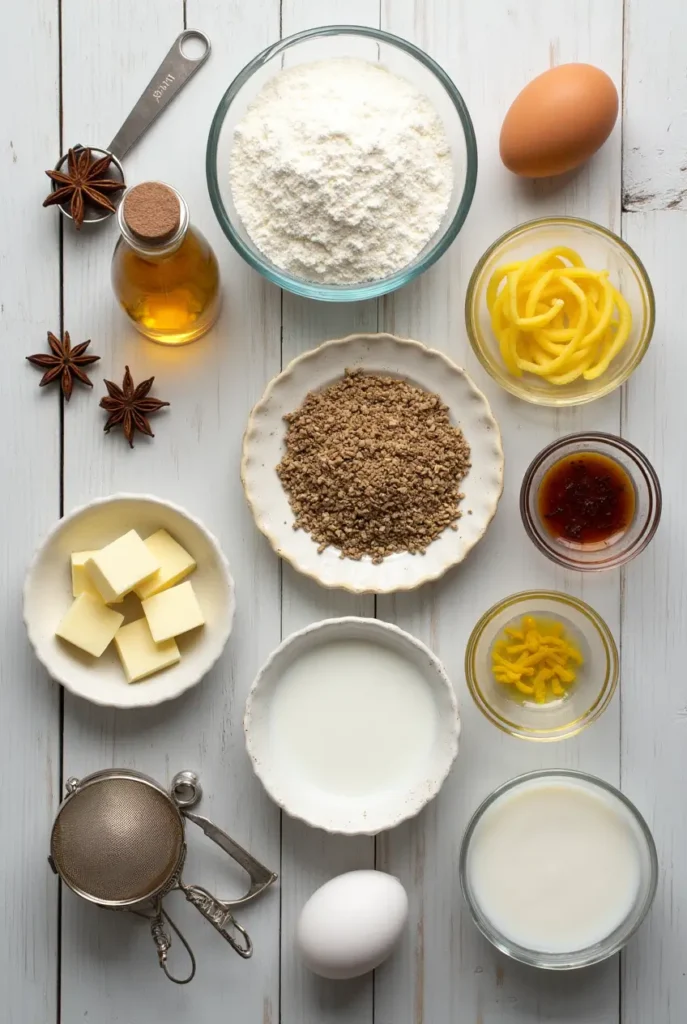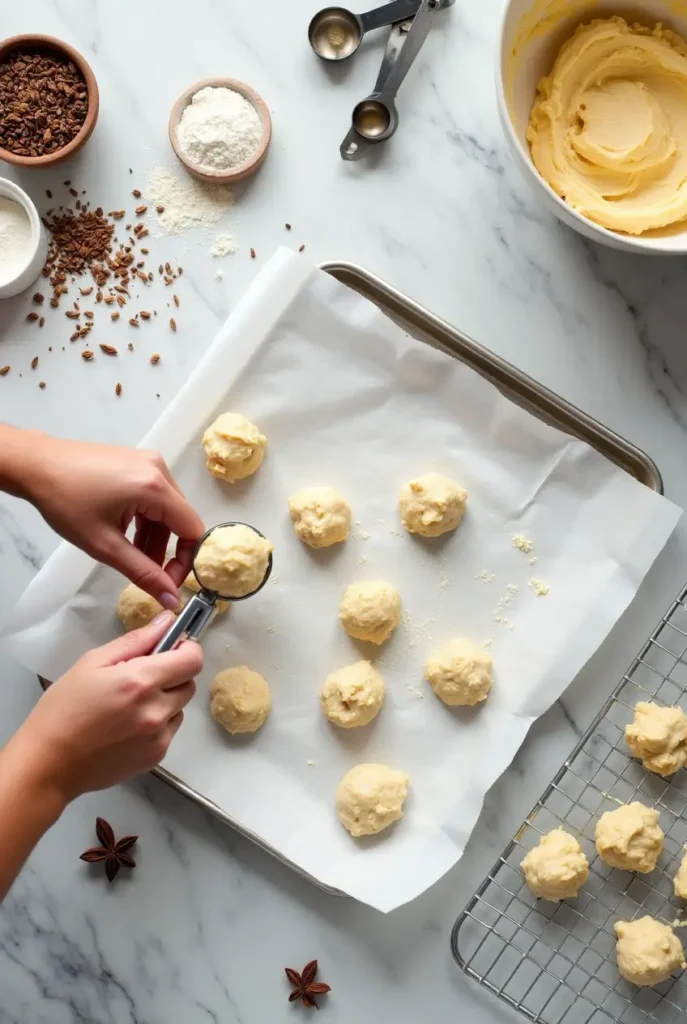The aroma of anise cookies baking in my grandmother’s kitchen is one of my most cherished childhood memories. That distinct licorice-like scent would waft through the house, signaling that something magical was happening in the oven. Whenever I bite into one of these delicate, crisp cookies now, I’m instantly transported back to those cozy Sunday afternoons watching Grandma work her baking magic.
Table of Contents :
Today, I’m sharing my grandmother’s closely guarded anise cookie recipe that has been passed down through generations. This isn’t just any recipe – it’s a foolproof method that guarantees perfect results every time, complete with step-by-step photos to guide you through the process. Whether you’re a seasoned baker or trying anise cookies for the first time, this recipe will help you create these delicious, aromatic treats that taste just like the ones Grandma used to make.
Before we get our hands floury, let’s take a quick journey into the history of these distinctive cookies and discover what makes this particular recipe so special. Trust me – once you master these anise cookies, they’ll become a staple in your baking repertoire!
What Are Anise Cookies?
Anise cookies are delicate, sweet treats flavored with anise – an herb that gives them their distinctive licorice-like flavor. If you’ve never tasted anise before, imagine a more sophisticated, slightly sweeter version of licorice with subtle floral notes. It’s that unique flavor that makes these cookies truly stand out in a crowd of holiday treats.
Anise itself has been used in cooking and medicine for thousands of years. Native to the eastern Mediterranean and Southwest Asia, this herb was popular in ancient Egyptian, Greek, and Roman cultures not just for its flavor but also for its digestive and medicinal properties. The Romans even created small anise cakes that were served at the end of feasts to aid digestion – perhaps the earliest ancestor of our modern anise cookies!
Different cultures have their own versions of anise-flavored cookies:
- Italian Anisette Cookies: Soft, cake-like cookies often topped with a sweet glaze and colorful sprinkles. These are especially popular during Christmas and Easter celebrations.
- German Springerle: Embossed cookies made with anise that feature beautiful raised designs. They’re typically made using special wooden molds that imprint elaborate patterns on the dough.
- Mexican Bizcochitos: Traditional anise-flavored cookies dusted with cinnamon sugar. These are particularly popular during Christmas and wedding celebrations.
- Dutch Kruidnoten: Small, spiced cookies that often include anise along with other warm spices like cinnamon, cloves, and nutmeg.
The recipe I’m sharing today is closest to traditional Italian anisette cookies – the kind my grandmother (who emigrated from a small town near Naples) would make for every family gathering. However, her secret technique and particular ingredient ratios make these cookies uniquely ours.

Why This Recipe Works
Ever tried to make anise cookies that turned out either too hard or too soft? Or maybe the anise flavor was either barely detectable or completely overwhelming? 🙂 Those are common issues with anise cookie recipes, but I’ve spent years perfecting Grandma’s method to address these exact challenges.
Here’s why this recipe consistently produces perfect anise cookies:
Precise Ingredient Ratios: The ratio of flour to butter to sugar has been carefully calibrated over generations. Too much flour makes the cookies dry and crumbly, while too little creates flat, spreading cookies. This recipe hits the sweet spot for a cookie that’s crisp around the edges but tender inside.
Temperature Control: Many recipes overlook the importance of ingredient temperature. Using room-temperature eggs and butter ensures proper incorporation and even baking.
Double Anise Method: Instead of just using anise extract OR anise seeds, this recipe uses BOTH for a perfectly balanced flavor that’s distinctive without being overpowering. It’s the secret to that authentic taste that so many recipes miss.
Rest Time: The dough needs a specific rest period (30 minutes, not more or less) to allow the gluten to relax and the flavors to meld. This step is non-negotiable for the perfect texture and taste!
Precise Baking Instructions: The exact rack position and temperature recommendations ensure even baking without burning the delicate bottoms of these cookies.
IMO, what truly makes this recipe special is how forgiving it is. Even if you’re new to baking, the clear instructions and troubleshooting tips will guide you to success. And for experienced bakers, the consistency of the results will make this your go-to anise cookie recipe.
Ingredients List : Anise Cookie Recipe

For the Cookies:
- 3½ cups all-purpose flour
- 1 tablespoon baking powder
- ½ teaspoon salt
- 4 large eggs, room temperature
- 1 cup granulated sugar
- ¾ cup unsalted butter, melted and cooled
- ¼ cup milk, room temperature
- 2 teaspoons pure anise extract
- 1 tablespoon whole anise seeds (slightly crushed to release oils)
- 1 teaspoon vanilla extract
- Zest of one lemon (optional but recommended)
For the Glaze:
- 2 cups confectioners’ sugar
- 3-4 tablespoons milk
- ½ teaspoon anise extract
- Nonpareil sprinkles (optional for decoration)
Notes on Ingredients:
Anise Extract vs. Anise Oil: This recipe calls for anise extract, which is more widely available. If using anise oil (which is more concentrated), reduce the amount to ¼ teaspoon.
Anise Seeds: For the best flavor, lightly crush the anise seeds using a mortar and pestle or the back of a spoon. This releases the essential oils and enhances the flavor.
Flour: All-purpose flour works best, but if you want a slightly lighter texture, you can substitute up to ½ cup of the all-purpose flour with cake flour.
Butter Substitution: While butter provides the best flavor, you can substitute with margarine in a pinch. However, the flavor and texture won’t be identical.
Milk: Whole milk is preferred, but 2% will work fine. Plant-based milks can be substituted, but they will slightly alter the flavor.
Equipment List
- Stand mixer with paddle attachment (or hand mixer with large bowl)
- Measuring cups and spoons
- Rubber spatula
- Parchment paper
- Baking sheets (2-3)
- Small cookie scoop (about 1 tablespoon capacity)
- Cooling racks
- Small bowls for glaze
- Whisk
- Fork or small spoon for drizzling glaze
- Airtight container for storage
Equipment Notes:
- No stand mixer? No problem! You can use a hand mixer, though it will require a bit more effort.
- If you don’t have a cookie scoop, two teaspoons work well for dropping consistently sized cookies.
- Silicone baking mats can be used instead of parchment paper.
- A microplane works best for zesting the lemon if using.
Step-by-Step Instructions : Anise Cookie Recipe

Step 1: Prepare Your Dry Ingredients
In a medium bowl, whisk together the flour, baking powder, and salt until well combined. This helps distribute the leavening agent evenly throughout the flour, ensuring your cookies rise properly. Set this mixture aside while you prepare the wet ingredients.
Step 2: Beat Eggs and Sugar
In the bowl of your stand mixer fitted with the paddle attachment, beat the eggs and granulated sugar on medium-high speed for about 3 minutes. The mixture should become pale yellow and slightly thickened – this is crucial for the light texture of the cookies! You’ll know it’s ready when you lift the paddle and the mixture falls back in ribbons.
Step 3: Add Butter and Flavorings
Reduce the mixer speed to low and slowly add the cooled melted butter, milk, anise extract, vanilla extract, crushed anise seeds, and lemon zest (if using). Mix until just combined – about 30 seconds. Don’t overmix at this stage!
Step 4: Incorporate Dry Ingredients
With the mixer still on low, gradually add the flour mixture. Add it in three batches, mixing just until incorporated after each addition. Once all the flour is added, mix for about 10 more seconds until no dry spots remain. The dough will be soft and somewhat sticky – that’s exactly how it should be!
Step 5: Rest the Dough
Cover the bowl with plastic wrap and let the dough rest at room temperature for exactly 30 minutes. This resting period is non-negotiable! It allows the flour to fully hydrate and the anise flavor to develop. While waiting, preheat your oven to 350°F (175°C) and line your baking sheets with parchment paper.
Step 6: Scoop the Dough
Using your cookie scoop, drop rounded tablespoons of dough onto the prepared baking sheets, spacing them about 2 inches apart. These cookies will spread slightly but not dramatically. For the most uniform cookies, level off each scoop before releasing the dough onto the baking sheet.
Step 7: Bake the Cookies
Bake one sheet at a time in the center of the oven for 10-12 minutes, or until the edges are just barely golden and the tops are set but not browned. Rotate the baking sheet halfway through baking for even browning. Be careful not to overbake – these cookies should remain pale!
Step 8: Cool Completely
Allow the cookies to cool on the baking sheet for 5 minutes before transferring them to a wire rack to cool completely. They might seem slightly soft when first out of the oven, but they’ll firm up as they cool.
Step 9: Prepare the Glaze
While the cookies are cooling, make the glaze by whisking together the confectioners’ sugar, milk, and anise extract in a small bowl until smooth. The consistency should be thick enough to coat the back of a spoon but thin enough to drizzle. If it’s too thick, add more milk a teaspoon at a time; if too thin, add more confectioners’ sugar.
Step 10: Glaze and Decorate
Once the cookies are completely cool, dip the tops of each cookie into the glaze, allowing the excess to drip off. Alternatively, drizzle the glaze over the cookies using a fork or small spoon. While the glaze is still wet, sprinkle with nonpareils if desired. Allow the glaze to set completely, which takes about 1-2 hours at room temperature.
Baking Tips and Troubleshooting
Tips for Perfect Anise Cookies:
- Temperature Matters: Make sure all refrigerated ingredients come to room temperature before starting. Cold eggs don’t incorporate air as well during beating.
- Don’t Rush the Egg/Sugar Beating: Those 3 minutes of beating eggs and sugar might seem excessive, but they’re crucial for incorporating air and creating the right texture.
- Measure Flour Correctly: Too much flour will make your cookies dry and crumbly. Spoon flour into your measuring cup and level it off with a knife rather than scooping directly from the container.
- Use Fresh Anise Seeds: The potency of anise seeds diminishes over time. For the best flavor, purchase fresh seeds and store them in an airtight container away from light.
- Don’t Overbake: These cookies should remain pale with just the slightest golden color around the edges. They’ll continue to firm up as they cool.
Troubleshooting Common Issues:
Problem: Cookies spread too much
- Solution: Your dough might be too warm. Try chilling it for 30 minutes before scooping and baking.
- Solution: You might need a bit more flour. Add 2 tablespoons extra next time.
Problem: Cookies are too hard or dry
- Solution: You likely overbaked them. Reduce baking time by 1-2 minutes in your next batch.
- Solution: You might have used too much flour. Remember to measure using the spoon-and-level method.
Problem: Anise flavor is too weak
- Solution: Your anise extract or seeds might be old. Purchase fresh ones for the best flavor.
- Solution: Increase anise extract by ½ teaspoon and/or increase crushed anise seeds to 1½ tablespoons.
Problem: Cookies are too pale
- Solution: This is actually how they should look! Anise cookies traditionally remain pale. If you prefer more color, you can brush them with an egg wash before baking.
Problem: Glaze is too runny
- Solution: Add more confectioners’ sugar, 1 tablespoon at a time, until you reach the desired consistency.

Variations and Adaptations
Want to put your own spin on these classic cookies? Here are some delicious variations to try:
Flavor Variations:
- Citrus Anise: Double the lemon zest and add 1 teaspoon of orange zest for a bright, citrusy version.
- Almond Anise: Add ½ teaspoon of almond extract to the dough and sprinkle sliced almonds on top of the glaze.
- Chocolate Dipped: Once the glazed cookies have set, dip half of each cookie in melted dark chocolate for an elegant contrast.
- Spiced Anise: Add ¼ teaspoon each of ground cinnamon and cardamom to the dough for a warming spice profile.
Dietary Adaptations:
Gluten-Free Version:
- Replace all-purpose flour with a high-quality gluten-free 1:1 baking flour blend.
- Add ¼ teaspoon xanthan gum if your blend doesn’t already include it.
- The texture will be slightly different but still delicious.
Vegan Version:
- Replace butter with vegan butter sticks (not spread).
- Use a flax egg replacement (1 tablespoon ground flaxseed mixed with 3 tablespoons water for each egg).
- Substitute plant-based milk for regular milk.
- Ensure your confectioners’ sugar is vegan (some brands use bone char in processing).
Reduced Sugar Option:
- Decrease the granulated sugar to ¾ cup.
- Use a lighter glaze or dust with just a little confectioners’ sugar instead of the full glaze.
- Add an extra ½ teaspoon of anise extract to maintain flavor complexity.
Shape Variations:
While the drop cookie method is traditional for this recipe, you can also:
- Roll the dough into logs, chill, and slice for uniform round cookies.
- Roll the dough ¼-inch thick and use cookie cutters for holiday shapes.
- Form the dough into small balls and flatten slightly with the bottom of a glass.
Serving Suggestions
Anise cookies are versatile treats that pair beautifully with various beverages and can be presented in multiple ways:
Perfect Pairings:
- Coffee: The strong flavor of coffee complements the licorice notes of anise perfectly. Try them with an espresso for an authentic Italian experience.
- Tea: Herbal teas like chamomile or mint create a soothing combination with these aromatic cookies.
- Dessert Wine: A small glass of sweet Vin Santo or Moscato d’Asti makes these cookies feel extra special.
- Hot Chocolate: For a contrasting flavor that works surprisingly well, try these cookies alongside rich hot chocolate.
Presentation Ideas:
- Arrange on a vintage plate with a doily for an old-world feel that honors their traditional roots.
- Stack them in clear cellophane bags tied with ribbon for a beautiful homemade gift.
- Create a cookie platter with anise cookies as the star, surrounded by complementary cookies like almond biscotti or lemon cookies.
- Serve with a small dish of coffee ice cream for an elegant dessert.
Gift Giving:
Anise cookies make wonderful gifts because they actually improve in flavor over the first day or two and stay fresh longer than many other cookies. Here are some gifting ideas:
- Layer them in a decorative tin between sheets of parchment paper.
- Include a handwritten copy of the recipe along with your gift.
- For holidays, package them with other traditional cookies in a cookie box.
- Attach a small bottle of anise extract to your gift package with a note suggesting they try making their own batch.
Storage Instructions
Properly stored anise cookies will maintain their flavor and texture for quite some time:
Room Temperature Storage:
- Store completely cooled cookies in an airtight container at room temperature.
- Place a piece of bread in the container to help keep the cookies soft (if you prefer them softer) or a small piece of apple skin (remove after 24 hours).
- Layer cookies between sheets of parchment paper to prevent sticking.
- Properly stored, they’ll keep for up to 2 weeks at room temperature, though the anise flavor actually deepens and improves over the first 24-48 hours!
Freezing Instructions:
- Unbaked Dough: The cookie dough can be frozen for up to 3 months. Scoop portions onto a baking sheet, freeze until solid, then transfer to a ziplock bag. Bake directly from frozen, adding 1-2 minutes to the baking time.
- Baked Cookies (Unglazed): Wrap cooled cookies tightly in plastic wrap, then aluminum foil, and freeze for up to 3 months. Thaw at room temperature and glaze when ready to serve.
- Glazed Cookies: Place in a single layer until glaze hardens, then stack between layers of parchment paper in an airtight container. Freeze for up to 1 month. Thaw uncovered at room temperature to prevent condensation from softening the glaze.
Reviving Stale Cookies:
If your cookies have lost their freshness, try these tricks:
- Warm in a 300°F oven for 3-4 minutes to refresh them.
- Place a slice of apple in the container overnight (but remove it the next day).
- Dip slightly stale cookies in coffee or milk just before eating for a delicious transformation.
anise cookie recipe

Love nostalgic flavors? This anise cookie recipe brings Grandma’s touch to your kitchen. Bake perfect cookies today. Try it now!
- 3½ cups all-purpose flour
- 1 tablespoon baking powder
- ½ teaspoon salt
- 4 large eggs (room temperature)
- 1 cup granulated sugar
- ¾ cup unsalted butter (melted and cooled)
- ¼ cup milk (room temperature)
- 2 teaspoons pure anise extract
- 1 tablespoon whole anise seeds (slightly crushed to release oils)
- 1 teaspoon vanilla extract
- Zest of one lemon (optional but recommended)
- 2 cups confectioners’ sugar (for glaze)
- 3-4 tablespoons milk (for glaze)
- ½ teaspoon anise extract (for glaze)
- Nonpareil sprinkles (optional for decoration)
- In a medium bowl, whisk together flour, baking powder, and salt. Set aside.
- Beat eggs and sugar on medium-high speed for 3 minutes until pale and thickened.
- Reduce mixer speed to low and add melted butter, milk, anise extract, vanilla extract, crushed anise seeds, and lemon zest. Mix for 30 seconds.
- Gradually add the flour mixture in three batches, mixing just until incorporated.
- Cover the bowl and let the dough rest at room temperature for 30 minutes.
- Preheat oven to 350°F (175°C) and line baking sheets with parchment paper.
- Scoop tablespoon-sized portions of dough onto prepared sheets, spacing 2 inches apart.
- Bake one sheet at a time for 10-12 minutes until edges are barely golden.
- Cool on baking sheet for 5 minutes before transferring to wire rack.
- Make glaze by whisking confectioners’ sugar, milk, and anise extract until smooth.
- Dip tops of cooled cookies in glaze and add sprinkles if desired.
- Allow glaze to set completely for 1-2 hours before storing.
Conclusion : Anise Cookie Recipe
There’s something truly magical about biting into an anise cookie that’s been made with care and tradition. The delicate balance of sweet cookie and aromatic anise creates an experience that’s both comforting and sophisticated – a treat that appeals to both young and old alike.
My grandmother’s recipe has stood the test of time for good reason. Its precise measurements, thoughtful techniques, and perfect balance of flavors create a cookie that’s not just delicious but also connects us to generations past. Each time I bake these cookies, I feel her presence in my kitchen, guiding my hands as I measure and mix.
I hope you’ll try this recipe and perhaps start your own tradition of anise cookie baking. Whether you follow it exactly or add your own twist with one of the variations, these cookies are sure to become a favorite in your recipe collection.
Have you tried making anise cookies before? Did you grow up eating them at family gatherings? I’d love to hear your stories and experiences in the comments below! And if you make this recipe, please leave a rating and let me know how they turned out for you.
Don’t forget to share this recipe with friends and family who appreciate traditional baking with authentic flavors. After all, the best recipes are the ones that get passed down and shared, creating new memories with each batch!
Author’s Top Recipe Picks :
- 8 Irresistible Cookie Recipes That Will Melt Your Heart
- 7 Secrets to Perfect Vegan Sugar Cookies with Almond Icing
- Soft And Chewy M&M Cookies: How To Make Them Irresistible

